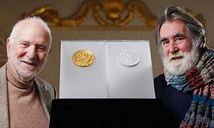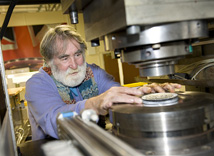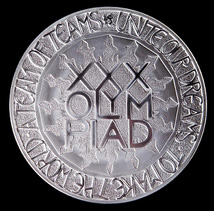The Olympic Kilo Coin by Maev Kennedy
This article first appeared in The Guardian 23rd November 2011
No ordinary purse could cope, but a poacher's pocket built for sturdy rabbits might do it, or a small wheelbarrow: in theory the Olympic coins just launched by the Royal Mint are legal tender, and can be dragged to the shops and spent today.
The coins, designed by the sculptor Sir Anthony Caro and the artist, author and ping-pong ace Tom Phillips, are the first ever one kilo UK coins in gold and silver.
"We're launching the new competitive Olympics team sport of synchronised coin striking," joked Phillips, adding "it's some consolation for yet again being passed over for the Olympics table tennis team."
Although the coins are legal tender – needing a special act of parliament – they're unlikely to turn up in a Tesco till or the toe of a Christmas stocking.
Apart from the difficulty of getting change, the silver coin, of which just 2012 are being struck, has a face value of £500 but will sell for £3,000. The gold has a face value of £1,000, but each of the 60 coins will cost collectors £100,000.
Phillips said: "When I was told it was the £500 coin I thought well I've done a 50p coin and a £5 coin so that's OK, that's promotion. And then that old paranoid competitive artist thing rose up in me, and I asked who was doing the gold coin. When I heard it was Tony I thought that's fine, old colleagues, old friends, it will be a thrill."
Caro, described by Sir Christopher Frayling, outgoing chair of the Royal Mint design committee, as "the leading sculptor of the post-Henry Moore generation", has never designed a coin before. As a student at the Royal Academy more than half a century ago, he was taught by Arnold Machin, who created the portrait bust of the young queen for both the coins and stamps, but said he "never paid any attention because I knew I didn't want to make coins".
Now, aged 87, he said: "I'm at a time of life when challenges are great and I value them." While Phillips worked in the traditional way by making drawings and paintings that were then scaled down, Caro went straight in, carving full-scale clay and plaster reliefs. His coin, the highest relief ever struck by the mint requiring a special press and production techniques, depicts a laurel wreath framing weights, boxing gloves, running shoes and a football – all chosen, he said, "because they were the easiest".
Phillips's coin shows a jolly circle of fluttering bunting – "as a war-time child everything was celebrated with bunting" – which also suggests flickering flames, surrounding the words XXX Olympiad. Around the outside runs his own little poem, in what he describes as "dancing letters": Unite our dreams, to make a team of teams.
Both artists winced at being required to incorporate the much-reviled 2012 logo. "I made mine as small as possible and then saw Tom's and realised I could get away with making it even smaller," Caro said. Phillips's appears as the full stop at the end of his verse.
Striking commemorative one kilo coins has been an Olympics tradition since Helsinki in 1952.
Frayling recalled that this project, and the design of scores of regular denomination coins representing all the Olympics sports, required endless meetings including one that lasted two days with meal breaks.
At one point some compassionate Olympics official suggested brightly: "Should we get in touch with TS Eliot to get a better sound bite?"
Phillips said he was very chuffed that he was getting one of his own coins to keep. "Tony isn't quite sure if he's getting his - he's a bit worried about it I think."
23rd November 2011 Maev Kennedy The Guardian
See the descriptive entry for The Olympic Kilo Coin for further details.



